|
There are many eye catching and whimsical wine labels that make one want to reach for the bottle regardless of style or origin of wine. I must admit that I have on very rare occasions bought a bottle just for the label! What can I say about these particular labels and wines? A lot! When I opened the shipping box delivered to me by the importers, I immediately thought that this was going to be a fun review! 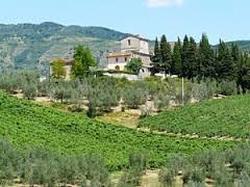 Paolo Masi, who is a third-generation winemaker at Renzo Masi winery, makes both of these wines. Fattoria di Basciano is the estate owned by the Masi family since the start of the 1900s. Located in the south of Florence, in Tuscany’s Rufina district, the estate sits on a hill overlooking the Argomenna Valley on one side and the right bank of the Sieve river on the other. The Renzo Masi winery produces a broad spectrum of wines from entry-level to fine and is considered one of the best areas for Sangiovese grapes after the “Classico” region. Renzo Masi’s motto is “Big enough to be broad-minded. Small enough to care about the details”. Affectionately called “Rubio and “Blanca”, Il Bastardo Sangiovese di Toscana IGT 2015 and La Bastarda Pinot Grigio di Siciliana 2015 tell their own story the minute the wine is opened. La Bastarda is 100% Pinot Grigio from Sicily. Grapes are picked before they lose their natural acidity and become too sweet. The color is a soft golden yellow with fruity aromas including citrus and honey. The palate is crisp with inviting notes of mild citrus, pear and apple. This is not your typical Pinot Grigio, exhibiting more character and structure than most I’ve tasted. One can only imagine what “Blanca” must be thinking as she poses with not a care in the world while sipping wine! Alcohol: 12.5% Price: About $9 Il Bastardo is 100% Sangiovese mostly picked from Tuscany’s Rufina district. The color is dark ruby with hints of purple. The nose offers dark berry and ripe cherry that segue onto the palate. Fennel, a hint of pepper and soft to medium tannins give this medium-bodied wine a smooth finish. So where is “Rubio” going on his motorbike? Is he off to find “Blanca” or is he running away with this delicious wine? Alcohol: 13% Price: About $9 Both wines are well priced and sold throughout the US. And in addition to being a conversation piece, the wines will complement a variety of dishes. Have some fun and enjoy the adventures of “Rubio” and “Blanca”!
Cheers! Penina
0 Comments
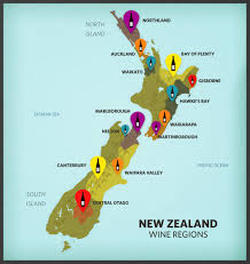 In my last post, I visited the Marlborough region of New Zealand. If you haven’t already read the post, please check it out for some background information about the terroir and wines. http://thewineknitter.com/1/post/2016/10/day-529.html Before I leave New Zealand for other parts of the world, there are two more wines that I’d like to share with you. Crowded House is part of Catalina Sounds and is located in the Marlborough region. The name Crowded House is derived from “the crowded, yet unique Marlborough region and our mission to stand out from this crowded world of wine.” Peter Jackson is the wine maker for both labels. 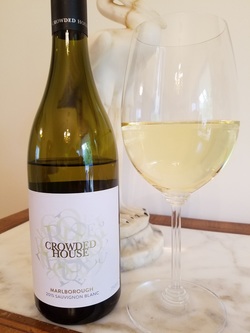 The Crowded House Sauvignon blanc 2015 is a fresh and zesty wine. The color is pale straw with aromas of tropical fruit, pineapple, citrus and hints of floral. The palate offers concentrated flavors of tropical fruit, soft citrus, pear and lemon zest on a long finish. The wine is beautifully balanced and would pair well with most seafood, salads, and light pastas or as an aperitif. Alcohol: 13% SRP: $12.95 http://www.crowded-house.co.nz  Nanny Goat Vineyard is located in Central Otago which is the most southerly wine region in the world. The vineyard is named after the wild goats that roam the mountainous terrain of the Central Otago. 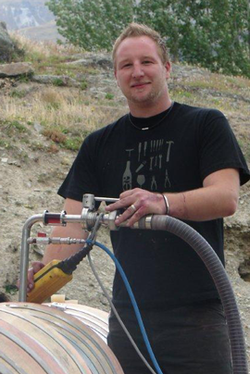 Alan Peters-Oswald Photo courtesy of Nanny Goat Alan Peters-Oswald Photo courtesy of Nanny Goat The extremely hot summers, very cold winters, rocky soils and poor fertility, make for challenging conditions in producing “world-class cool climate wines”. However, winemaker, Alan Peters-Oswald who grew up in rural Central Otago farming Angora goats, now produces premium Pinot Noir, Chardonnay and Syrah after getting his Diploma in Viticulture and Wine Production in Marlborough. 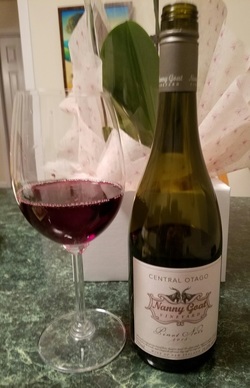 The Nanny Goat Vineyard Pinot Noir 2015 reflects the terrior and story of this vineyard. The color of the wine is dark cherry with berries, plum and spice on the nose. The palate is rich with layers of cherry, plum, blackberry, raspberry and violet. Soft tannins and a silky mouth-feel lead to a lengthy finish with hints of pepper and oak. This medium-bodied wine paired nicely with the Dijon crusted salmon and vegetable couscous. It would also complement stews, hearty soups and meat entrees. Alcohol: 14% SRP $23 http://nannygoatvineyard.co.nz The wines are priced well and would be a nice addition the holiday table.
Have a great Thursday! Cheers! Penina Having recently received a delightful lineup of wines from New Zealand, I thought it would be fun to “fly” over there and check out the wine scene. 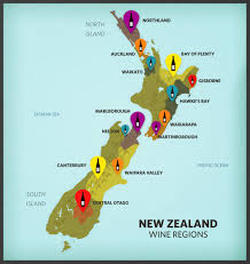 New Zealand is an island nation comprised of two islands (North and South) in the southwestern Pacific Ocean that extends 1000 miles with eleven wine regions ranging from sub-tropical Northland to the world’s most southerly grape growing region Central Otago. Vineyards profit from the maritime climate with long hours of sun and cool nights. In fact, no vineyard is further than 80 miles from the ocean. According to stats from WineInstitute.Org, for the year 2014, New Zealand produced about 1.13% of the world’s wine and ranked #15, with France, Italy and Spain leading the pack. Although New Zealand wine production might be low, an impressive collection of varieties and styles are making their presence known. New Zealand has been making wine since the 1800s, with the oldest existing vineyard being established in 1851 by French Roman Catholic missionaries at Mission Estate in Hawke’s Bay. There are many grape varieties found throughout the wine regions such as Sauvignon Blanc, Chardonnay, Pinot Gris, Riesling, Gewurztraminer, Pinot Noir, Cabernet Sauvignon, Merlot and Syrah. Catalina Sounds is a small estate located in the Marlborough region, which is the largest wine region in the country. Marlborough region occupies the northeastern corner of the South Island. Eighty percent of New Zealand’s Sauvignon blanc is grown in Marlborough, followed closely by Pinot Noir and Chardonnay. Many critics believe that Marlborough produces some of the world’s best Sauvignon blanc. 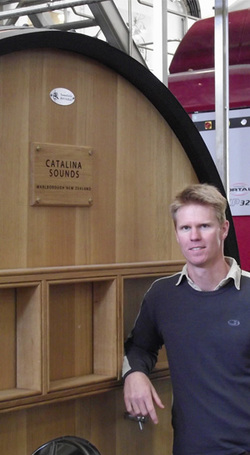 Peter Jackson Photo courtesy of Catalina Sounds Peter Jackson Photo courtesy of Catalina Sounds Peter Jackson is Catalina Sound’s wine maker and his philosophy is simple: “Source outstanding fruit from exceptional vineyard sites. I believe the most critical decision a winemaker makes is deciding when to pick. Once harvested, my role is to simply steer the fruit in the right direction in order to best express the vibrant fruit flavors that Marlborough is renowned for while respecting the subtle differences of each site”. Catalina Sounds 2015 Sauvignon Blanc is primarily sourced from Catalina’s “Sound of White” vineyard situated in Waihopai Valley. This is a beautiful and very friendly wine! The color is pale straw with enticing aromas of tropical fruit, peach, citrus and herbs. The palate offers layers of stone fruit, citrus, apple and floral notes. Nicely balanced with “juicy” acidity, the finish is dry and long. This wine would pair well with a variety of appetizers, light fish, cheese & fruit or on it’s own! Alcohol: 13% SRP: $16 Catalina Sounds 2015 Pinot Noir is sourced from Sound of White vineyard in Waihopai Valley and the Clayridge vineyard in Omaka Valley. Dark ruby in color, delicious aromas of sweet and sour cherry, earth and spice greet the senses. The palate is a lovely blend of berries, cherry, plum, spice and hints of oak followed by a long finish of lingering herbs and spice. Medium-bodied with a silky mouth-feel and soft tannins, this is an ideal wine for meat, poultry and hearty stews. It completed the Pumpkin Red Lentil Chili I made the other evening. The wine soothed the fire on my palate while adding another great taste sensation! Alcohol: 13% SRP: $19 My next post will be about Crowded House and Nanny Goat Vineyards. See you in New Zealand again soon!
Cheers! Penina  Best laid plans often go awry. Without going into detail, I missed my train to the Wines of Portugal event yesterday. However, I have lots of information about these delicious wines from my attendance at the event last year. If you haven’t already read them, here are the links to previous posts about wines of Portugal. http://thewineknitter.com/1/post/2015/10/day-360-wines-of-portugal.html http://thewineknitter.com/1/post/2015/10/day-361-more-wines-of-portugal.html http://thewineknitter.com/1/post/2015/10/day-371.html  So, instead of spending an afternoon in Portugal, I ended up in France! Lunching with a good friend in a cozy and authentic French bistro was the cure-all for a rainy day. We leisurely sipped on Philippe Prié ‘Depuis 1737’ Brut Tradition Champagne while catching up on life. Maison Philippe Prié is located in the heart of the Côte des Bar in the south of the Champagne region. They have been producing wines since 1737. All of their vintages are a blend of Chardonnay (giving it elegance and grace) and Pinot Noir (adding impressive structure). The 30 year-old vines are grown in clay and limestone soils. This particular blend is 80% Pinot Noir and 20% Chardonnay. This is a light but beautifully textured champagne. Invitingly aromatic with fine bubbles, the palate is entertained with tart apples, citrus, peaches, floral and a hint of honeysuckle on the finish. It is crisp and clean with a creamy mouth-feel. I am definitely adding this to my holiday list! Happy Friday!
Cheers! Penina  The World Series begins this evening and it is going to be very exciting with two “underdog” teams playing, the Indians vs. Cubs. I’m rooting for the Cubs! And you? For the next week or so, most of us will be gathered around the television as baseball takes over our lives. Selecting the right food and drink is key while viewing the games. Finger food is great to serve because it requires the least amount of attention to eat. You don’t won’t to be slicing a steak or twirling spaghetti and miss out on a grand slam or someone stealing bases! A variety of “tea size” sandwiches work well, as does mini crab cakes, sushi, and sliders. You can turn most any recipe into bite size portions. Unless you’re watching the game at a bar or restaurant where the bartender is shaking up the cocktails, forget about serving complicated drinks or you’ll be spending most of your time in front of a blender or martini shaker. Wine, beer, cognac and single shot spirits work best. So, have a great evening watching the Series Opener and I’ll be back soon with thoughts on New Zealand wines and some interesting seminars I attended at Simply Italian Great Wines Tour US.
Happy Tuesday! Cheers! Penina  With the much-needed rain pouring down, it’s a perfect time to catch up on writing and sample a few wines. Let’s travel to Italy. Astoria Wines is located 50 miles north of Venice in one of the most beautiful wine-growing regions, the Veneto. This northeastern region of Italy stretches from the Dolomite Mountains to the Adriatic Sea. The Alps and the sea protect the region from harsh northern winds which in turn provide ideal conditions for growing grapes and producing wine. Astoria Wines is owned by the Polegato family and represents four generations of winemaking. The first winery, Vinicola Polegato, was established in the 1950s. Several decades later, Vittorino Polegato found an ideal location in the heart of the DOCG area to launch the next stage of the family business, the Val De Brun estate in Refrontolo. In 1987 Vittorino renovated an old 18th century home and converted it into Astoria’s headquarters. Giorgio and Paolo Polegato, (Vittorino’s sons) along with the next generation of Polegatos, led by Filippo, Carlotta and Giorgia, uphold the family name and winemaking tradition. Although Astoria Wines is noted for being the largest private producer of Prosecco DOCG in Italy, their portfolio includes Pinot Grigio, Moscatos (both red and white), Pinot Noir and a Red Blend. 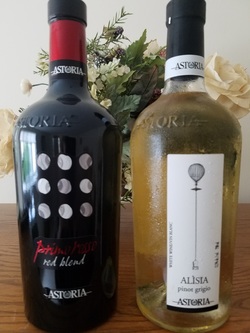 The first thing I noticed when unpacking the wines was the unusual shape of the bottles. The packaging is eye-catching and original. The 2014 Alisia Pinot Grigio I.G.T is light yellow in color with intriguing aromas of fruit, floral and stone fruit. This 100% Pinot Grigio surprises the palate with fruit, peach and lemon. It is medium-bodied and dry but still fruity and nicely balanced. The long lemon zest finish is a treat! This wine would pair well with pasta, cheese & fruit, grilled vegetables and light fish. Alcohol: 12.5% SRP: $11 The 2012 Primo Rosso Red Blend I.G.T is made with 50% Cabernet Sauvignon, 30% Pinot Noir and 20% Merlot. The color is dark ruby. It is quite aromatic with berries, herbs and spice tickling the nose. The palate offers red berries, fennel, pepper and hints of plum. The finish has hints of cocoa and dark cherry. Medium-bodied with soft tannins make this an easy wine to pair with most foods. Alcohol: 13% SRP: $11 The wines are priced well and would make great little gifts to give out at holiday time. Keep a few bottles around for that spur of the moment party as well!
Next stop might be New Zealand. Stay tuned! Happy Friday! Cheers! Penina It was a beautiful day in NYC yesterday. The temps hovered around 80 degrees and everyone was enjoying a day of summer in the middle of October! 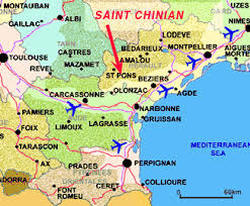 I attended the Saint-Chinian walk-around wine tasting held at the Maison de la Région Occitanie. The event featured The Languedoc: Saint-Chinion wines represented by thirteen wine producers. I tasted some amazing wines which I will elaborate on over the weekend. I will also talk about the appellation, the vines and some of the producers. When I arrived home last evening, I reached for the Château Gassier Ormilles Côtes de Provence Rosé 2015 that was chilling in my refrigerator. With the warm weather and the taste of Saint-Chinian still on my palate, it was a perfect time to pop the cork! Although Provence is several hours away heading east, I was still in France! I reviewed this wine back in June. You can read the review at: http://thewineknitter.com/1/post/2016/07/day-484.html Have a great Tuesday!
Cheers! Penina It is not uncommon for UPS and Fed-Ex to deliver wines to my door from wineries, PR agencies and importers. I love exploring regions, discovering new wines and learning about the winemakers without having to pack a suitcase. Of course, nothing compares to actually walking through a vineyard with glass in hand! 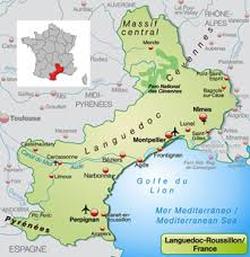 Most recently, I received a box of wines containing samples of Michel Chapoutier’s 2015 Domaine de Bila-Haut “Les Vignes” Rouge and “Les Vignes” Blanc. Domaine Bila-Haut is located in the region of Côtes de Roussillon, Languedoc. It is in Southwest France, and very close to Spain.  Michel Chapoutier Michel Chapoutier Michel Chapoutier is head of Maison M. Chapoutier. He is world-renowned and is one of Rhône’s most famous wine producers of Hermitage, Chateaneuf du Pape and Côte Rôtie to name just a few. He purchased the 190-acre Domaine Bila-Haut in 1999 . It was a neglected property but showed promise with the land being a mix of schist, gneiss and clay. With Chapoutier’s knowledge, expertise and passion along with the climate of the Mediterranean, he turned the land into a perfect growing environment for Syrah, Grenache and Carignan. Bila-Haut wines reflect all of this. Les Vignes de Bila-Haut Rouge is elegant. This is a beautiful blend of Syrah, Grenache and Carignan. The color is so dark it borders on violet. Intense aromas of dark cherry, blackberry, spice and herbs are present. The palate offers lots of dark fruit, plum and pepper. The “jammy” flavors blend well with the spice. The wine is medium-bodied with soft tannins and an extra treat of pepper and chocolate on a long finish. Alcohol: 14.5% Les Vignes de Bila-Haut is a lovely blend of 50% Grenache Blanc, 20% Marsanne, 20% Macabeo and 10% Vermentino. It is interesting to note that only 4% of the grapes in this region are allocated to white wine. And, Michel Chapoutier has done a stunning job of capturing the essence of these varietals. Soft yellow in color, this crisp wine is very aromatic with citrus, vanilla, floral, lemon and hints of stone fruit that segue onto the palate. It has a creamy mouth-feel with a lingering bit of zest and the sea on the long finish. Alcohol: 13.5% The wines are available nationally and on select wines lists as well. They retail for about $15.
Both wines will pair well with a variety of foods. With the holidays approaching, these are wonderful wines to serve with appetizers, entrees and even dessert! They are a great value for the price and easy wines to drink! Enjoy! Cheers! Penina 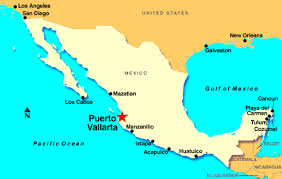 The temperature in Puerto Vallarta yesterday was a sunny 77 degrees. I enjoyed a few hours basking in the culture, albeit I was 2766 miles away! Through the wonderful hospitality of Puerto Vallarta Tourism, I tasted the local cuisine, learned about the culture and all the fun activities that are available in this magical resort.
There are vacation packages to accommodate everyone including family packages, honeymoon packages…and wait for it…divorce packages! There truly is something for everyone! Most of the resorts are all-inclusive and offer great deals. My afternoon started with two traditional non-alcoholic Mexican beverages, Horchata and Agua de Jamaica. Horchata is made with rice, ground almonds, milk, cinnamon and sugar. It is delicious and not too sweet. Agua de Jamaica is made with dried hibiscus flowers and water. It is prepared much in the same way as brewing tea. It was tart, but refreshing. Chef Mario Portillo entertained us with stories as he demonstrated and prepared lunch. Mario began his foray into cooking at the age of five when he helped his father prepare omelets. He has been a chef for the past ten years and will be opening his own restaurant in Puerto Vallarta on October 19th. We were served family style salad and Sea Bass with pineapple-smoked puree on top of bean salad with tomatoes, red onion, peppers and cilantro. It was delicious! The local fish of Puerto Vallarta is Mahi Mahi, Red Snapper, Marlin, Oysters, Octopus, Mussels and Shrimp. Using quality ingredients from the sea and land, there is ample opportunity to sample local fare while vacationing. Pescado embarazado (pregnant fish) is a typical representation. It is grilled fish on a stick that has been marinated in lime over coals and served with huichol salsa. Another favorite dish is Birria, using goat or lamb which is cooked in a very spicy sauce. Tamales, chiles en nogada, shrimp stew, Pico de Gallo and plantain empanadas are also local favorites.
Of course, what would visiting Mexico be without tasting Tequila or touring a distillery! Tequila is made from the Blue Agave plant that is native to Mexico. Tequila is only produced in the state of Jalisco and a few limited municipalities. There are over 1377 registered brands of Tequila to choose from. In addition to Tequila, Damiana, Mezcal, Xtabentún, and Raicilla are also native Mexican drinks. Damiana is an herbal-based liqueur made from the Damiana herb. Mezcal is a distilled beverage made from any agave plant that grows in Mexico. Xtabentún is made from anise seed and fermented honey that is produced by honeybees from the nectar of xtabentún flowers. Rum is then added to the mixture. Raicilla is a distilled spirit. Although it is similar to Tequila and Mezcal, Raicilla is considered a “moonshine” product. I’m looking forward to hopping on a plane to Puerto Vallarta and hopefully spending more than just a few hours enjoying beautiful weather, great cuisine and a little adventure! Salud! Penina 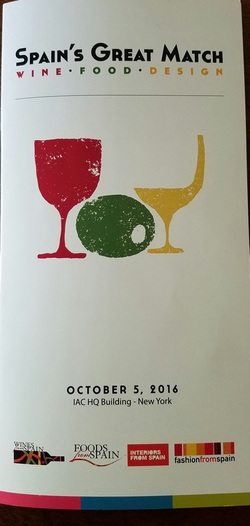 It was a beautiful day for touring the wine regions of Spain at Spain’s Great Match Wine Food Design event. There were more than 300 wines to taste from seven wine regions and culinary treats to savor from New York’s top Spanish restaurants. There were thirty-five featured denominations of origin represented in addition to several wine seminars being offered. It was a whirlwind event and I learned a lot. Spain is no stranger to wine making with a history dating back at least three thousand years. The Phoenicians planted grapes around 1100 BC in what is known today as the Sherry region. Wine commerce ended with the arrival of the Islamic Moors in 711 AD and did not commence again until the Moors were defeated in 1492. Jumping ahead to the present, according to the International Organization of Vine and Wine, as of 2015, Spain ranks 3rd in wine production, with Italy and France taking the lead. An interesting fact: Spain has more land devoted to vineyards than any other European country. Over 400 varieties of grape are planted throughout Spain. Here is a very small list of principle indigenous grapes. Tempranillo is Spain’s most famous and noble red grape. Garnacha, Mencía, Monastrell and Cariñena are just a few of Spain’s other noted red grapes. Albariño, Verdejo, Godello, Palomino, Malvasía Moscatel and Xarel.Lo are among some of Spain’s well-known white grapes. In future posts, I’ll be talking about Cava Sparkling Wine, Spain’s answer to Champagne and Sherry, a fortified wine that originated in Spain. In the meantime, I have put together a mini slide show to give you a "taste" of the event, because sometimes a picture is worth a thousand words! And yes, the wines were delicious and memorable! Just click on the photo to pause, forward or reverse. Have a great weekend!
Cheers! Penina |
Categories
All
|

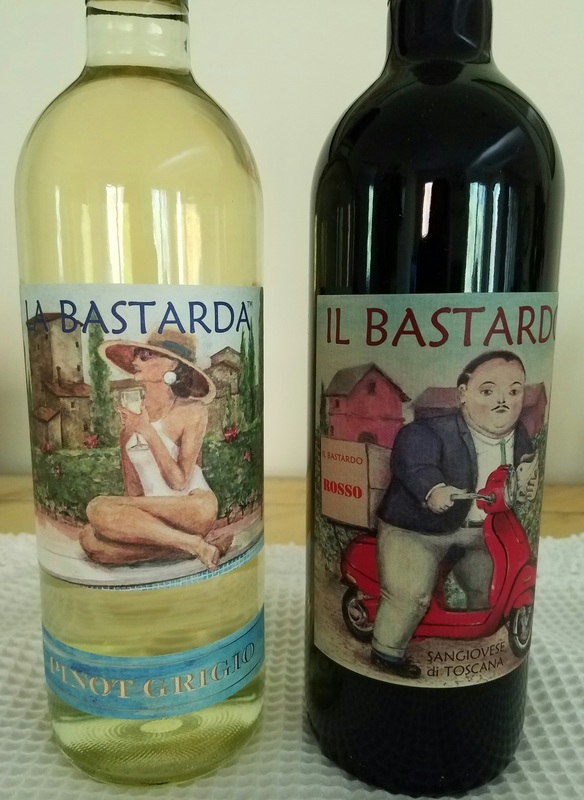
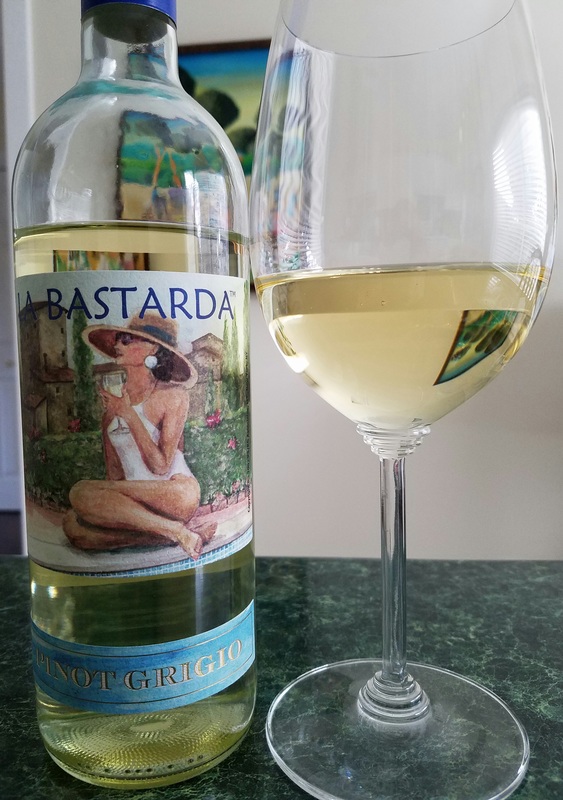
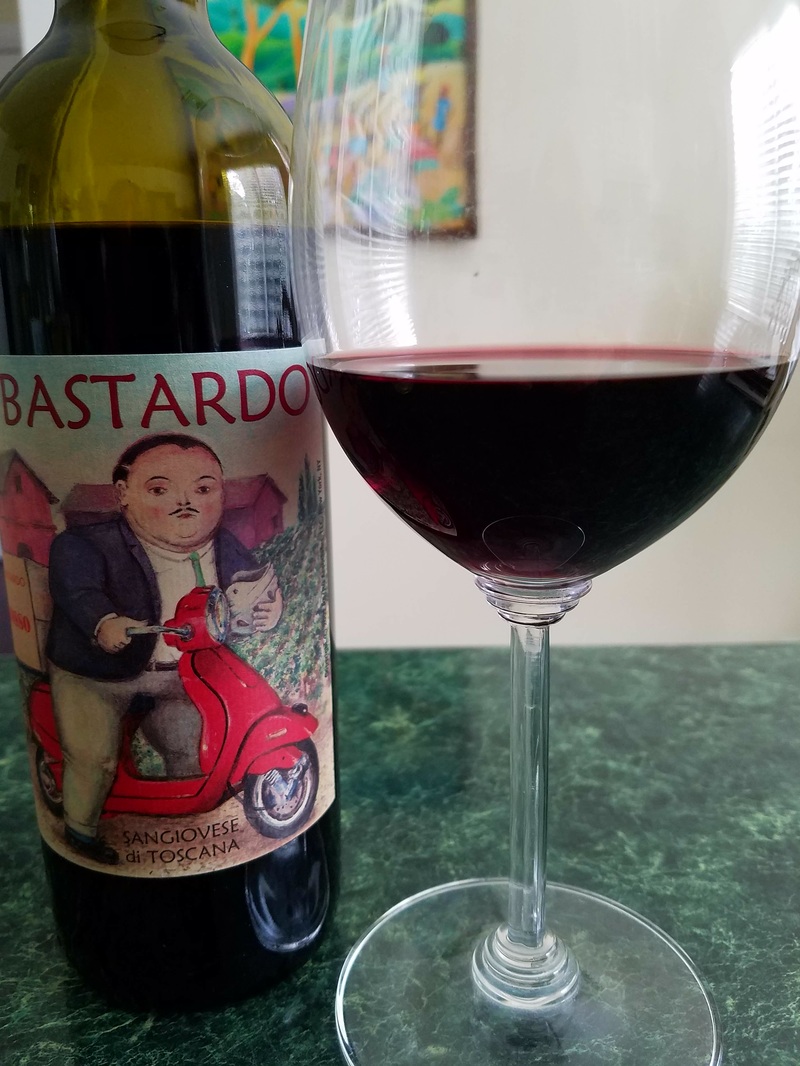
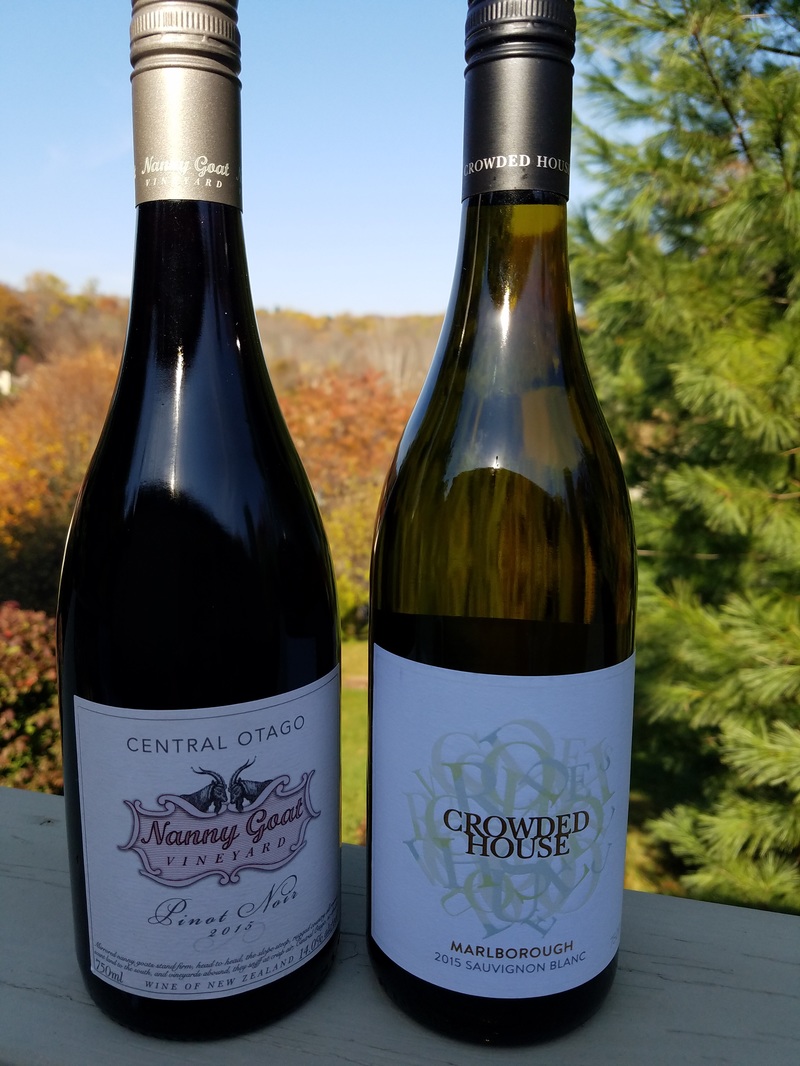


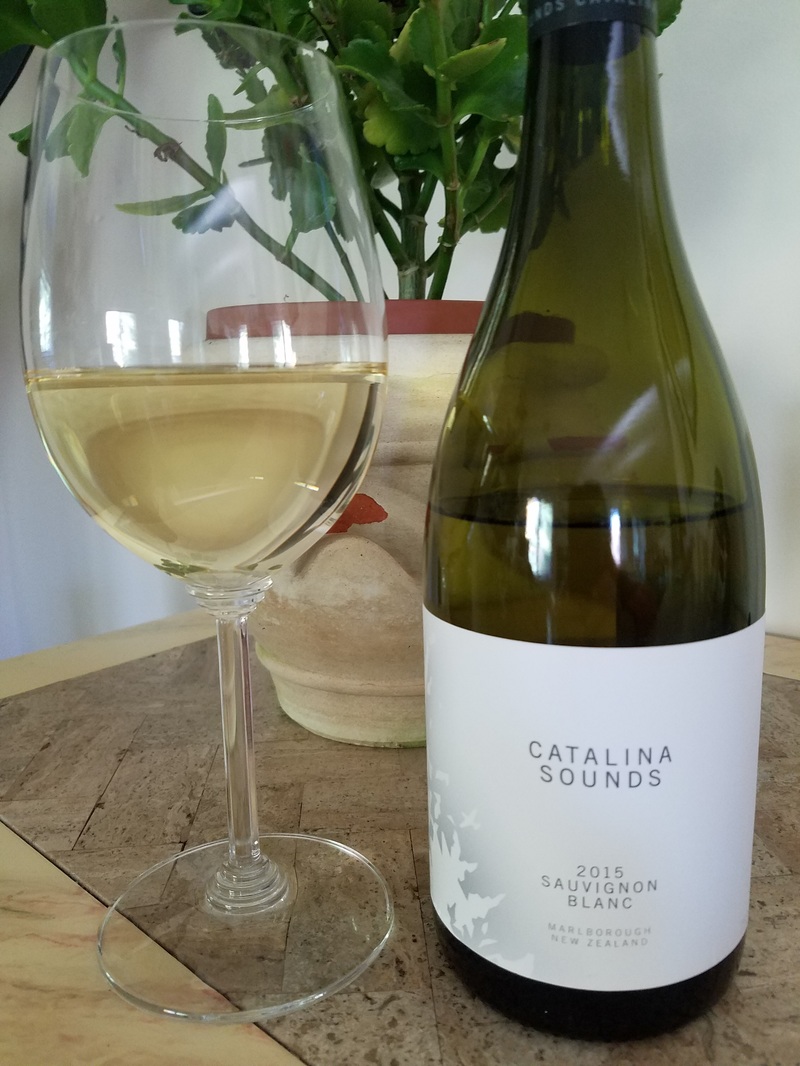
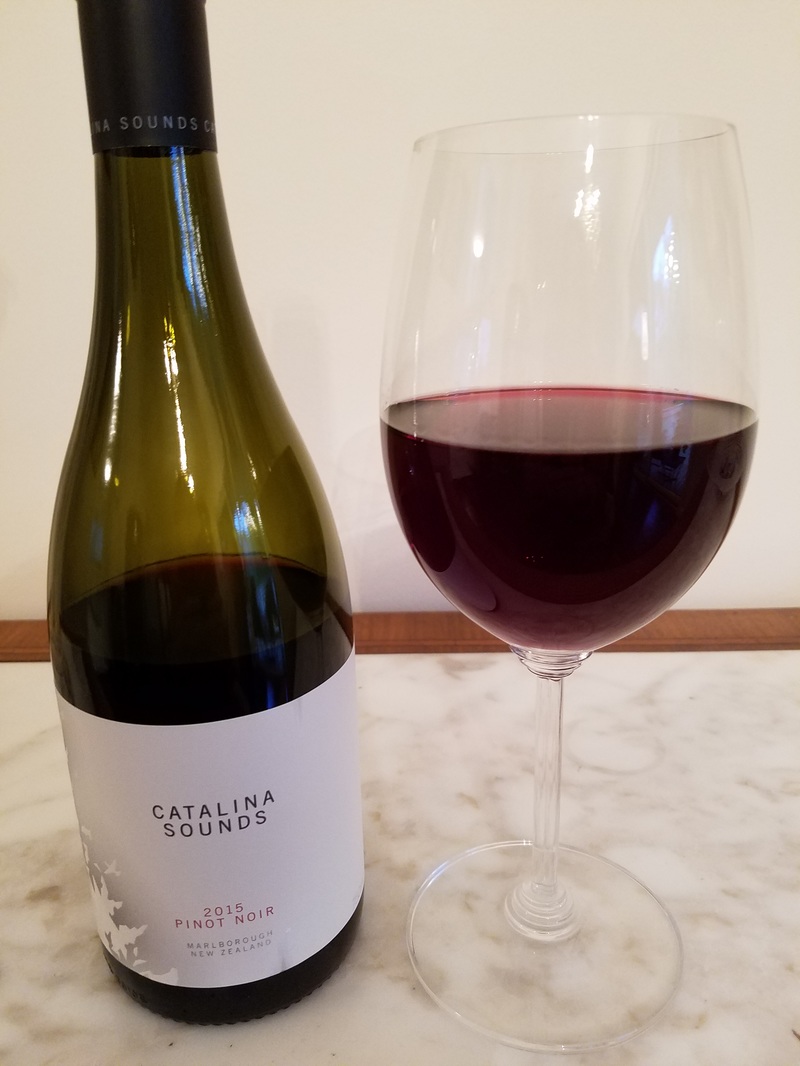
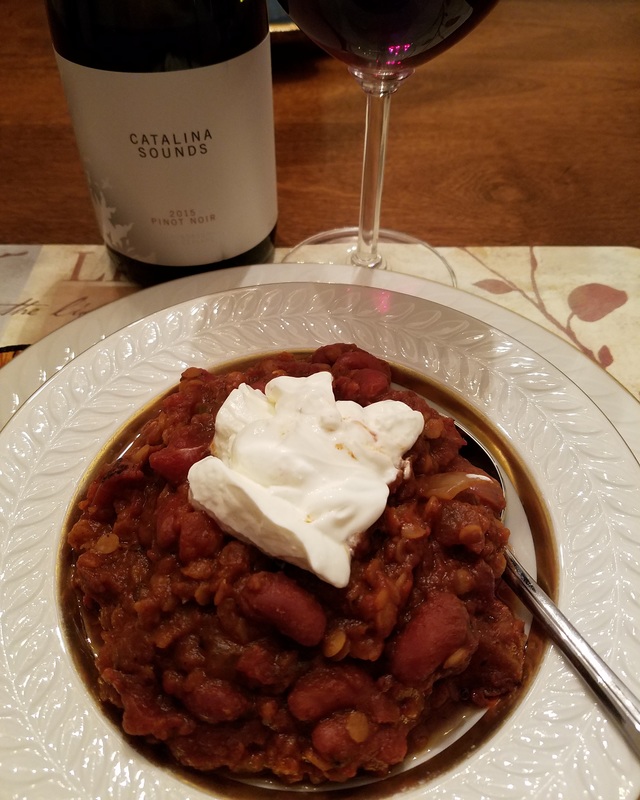
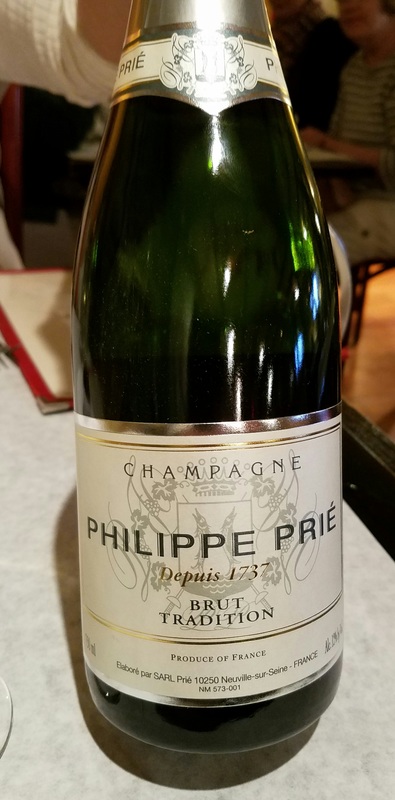
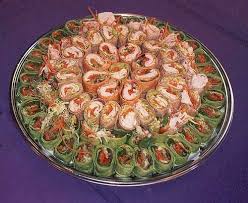
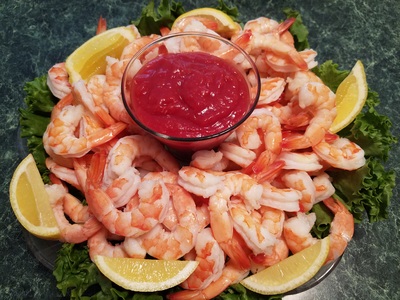
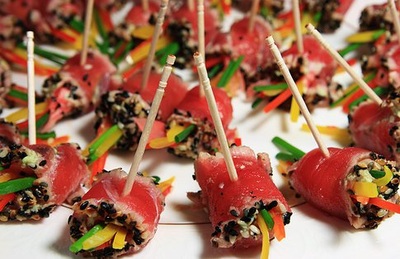


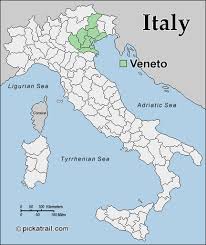
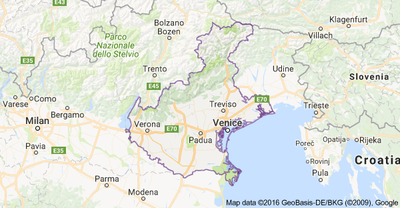
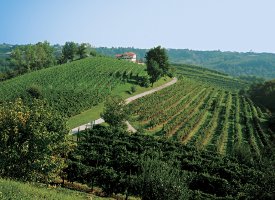
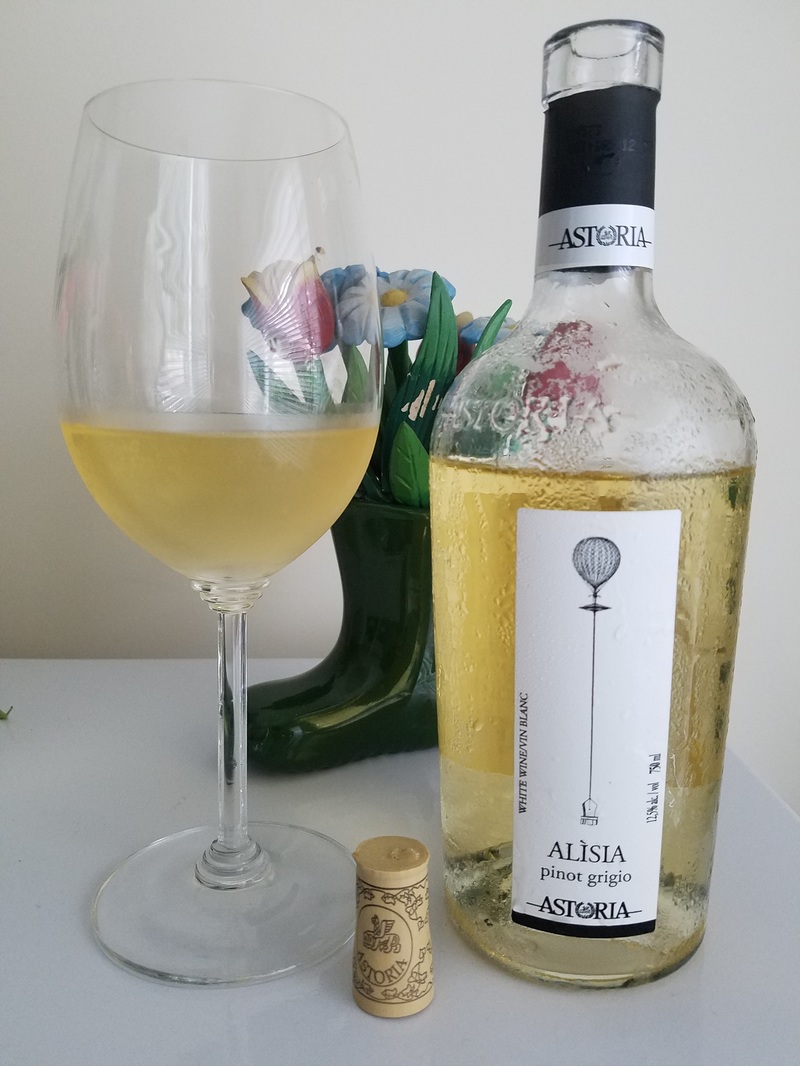
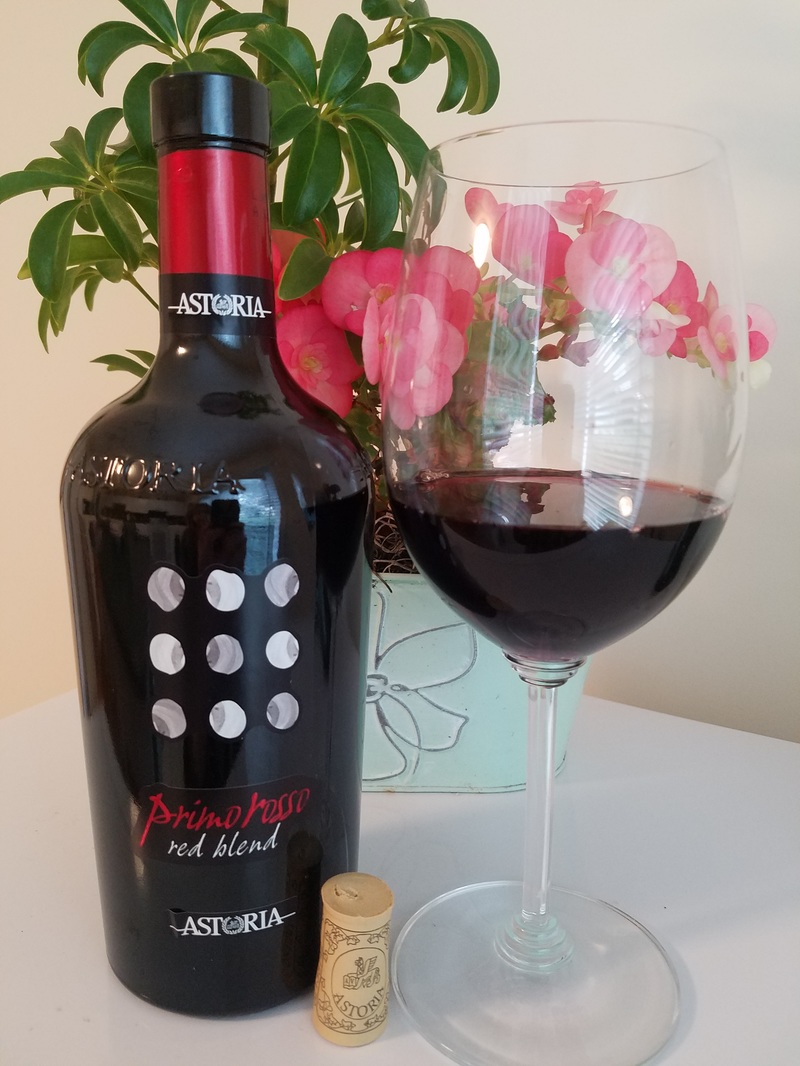
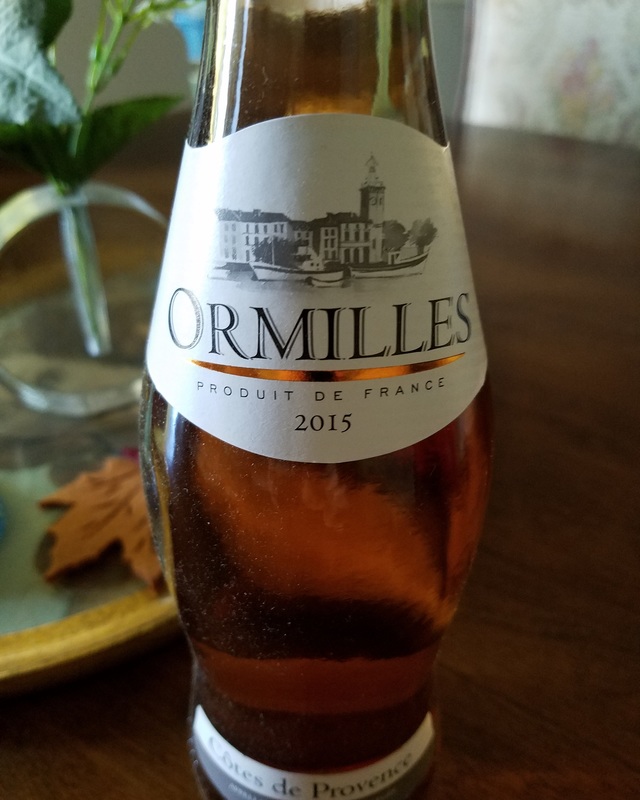
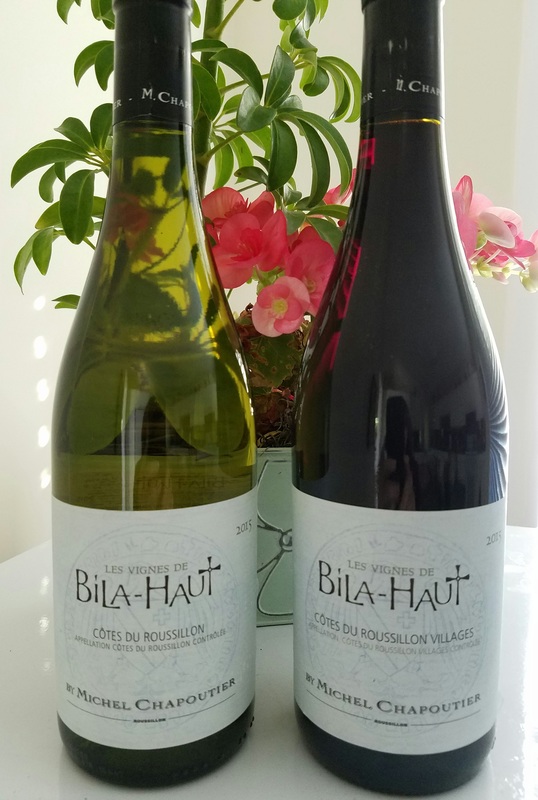
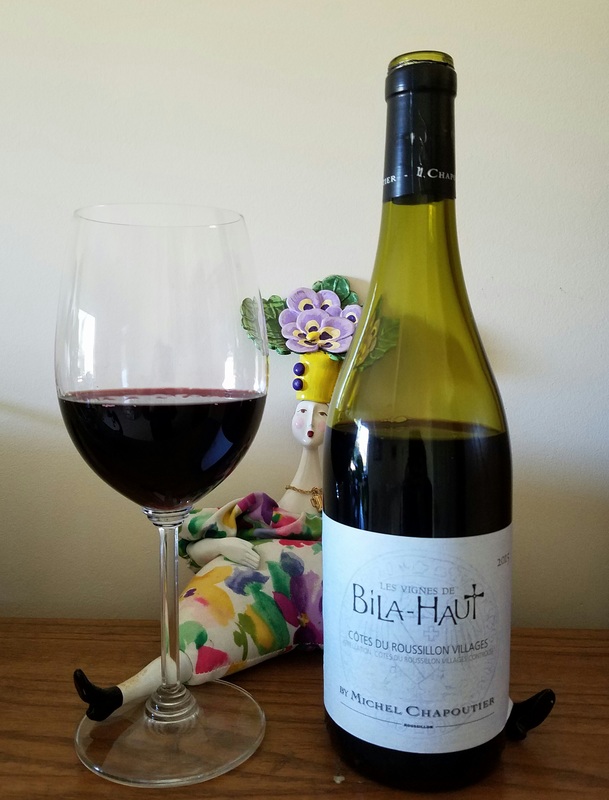
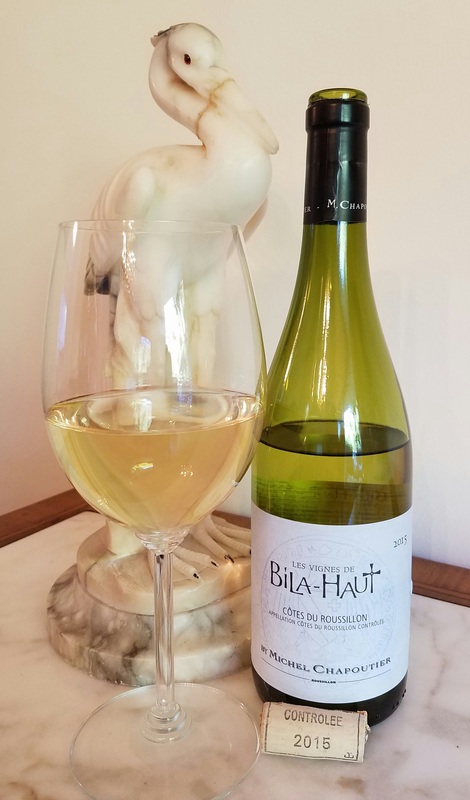


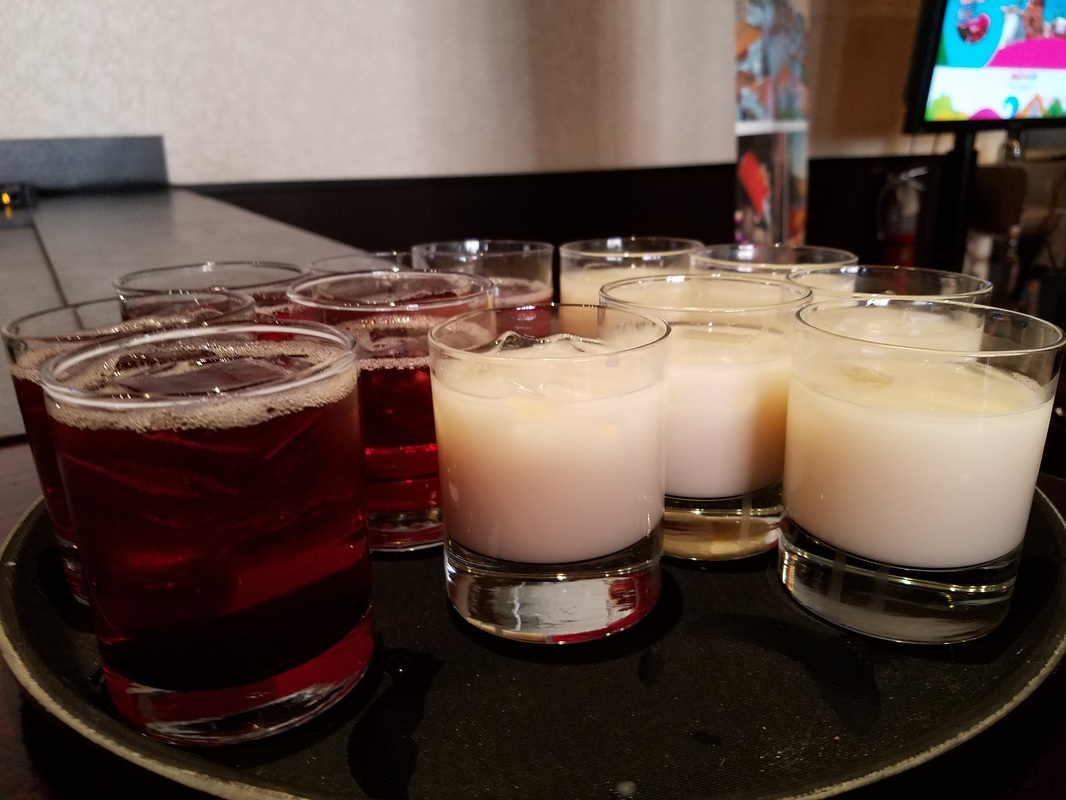
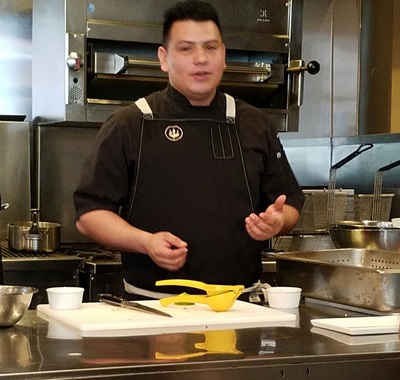
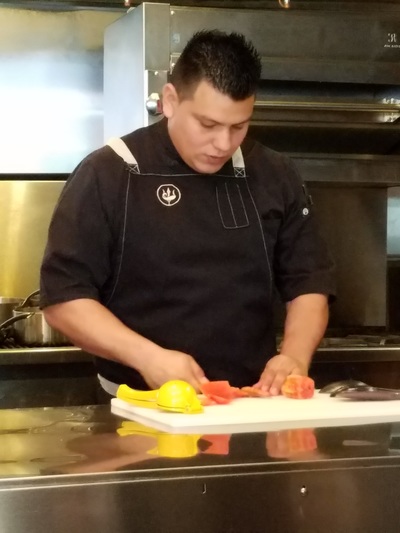
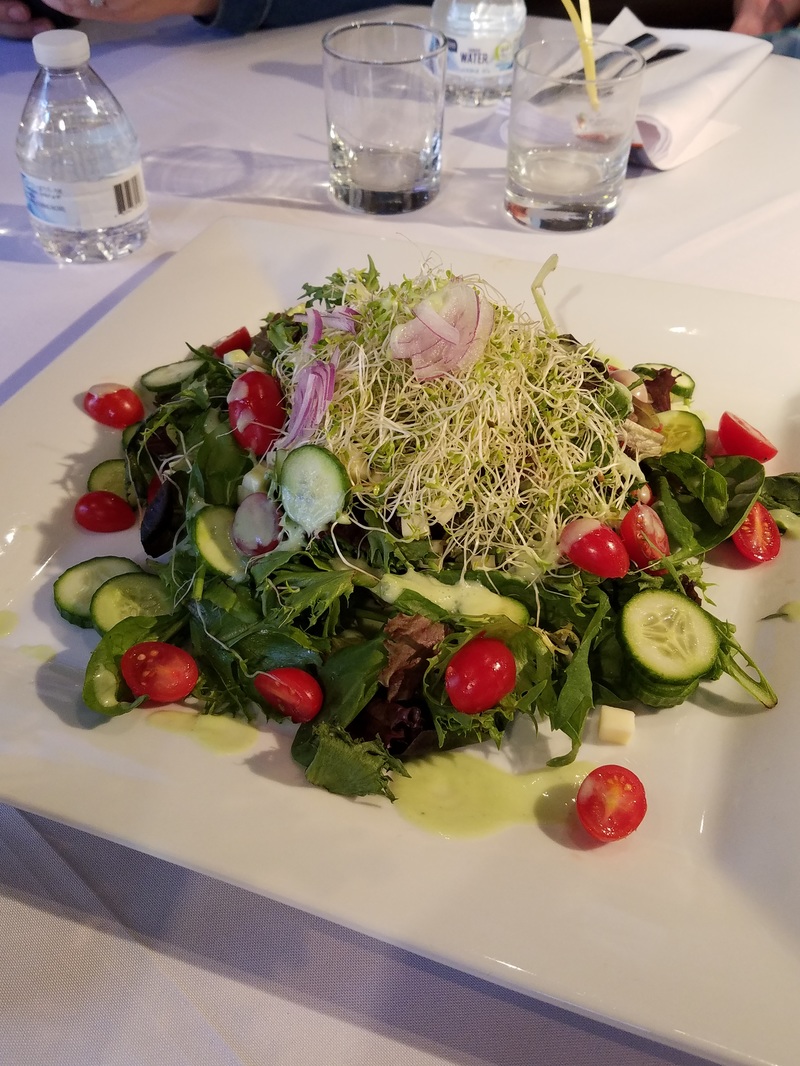
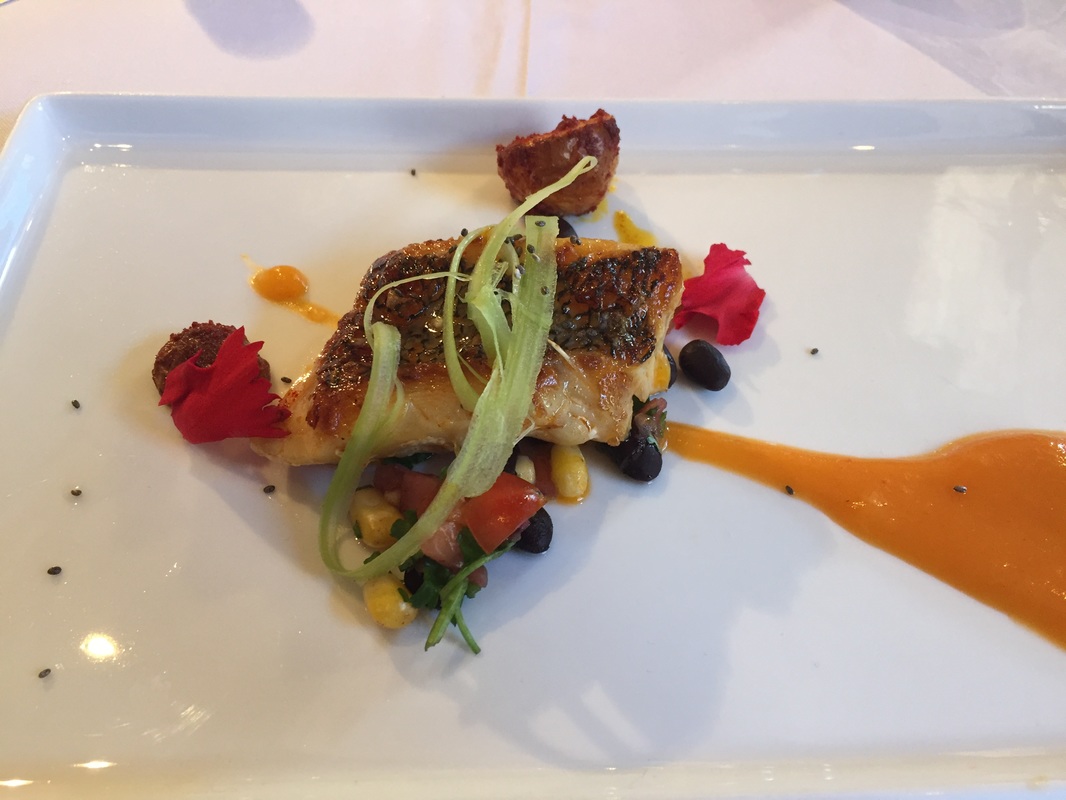

 RSS Feed
RSS Feed